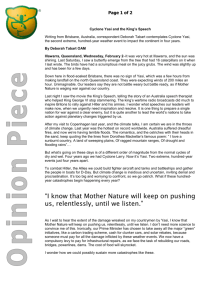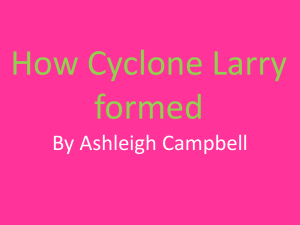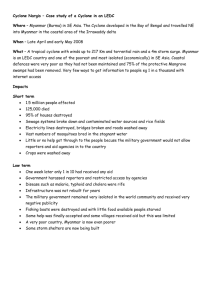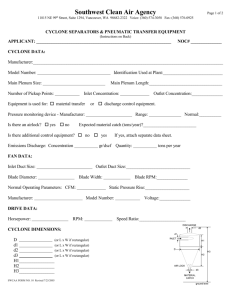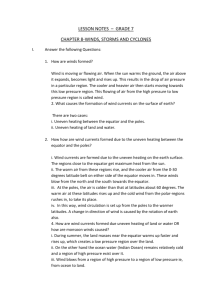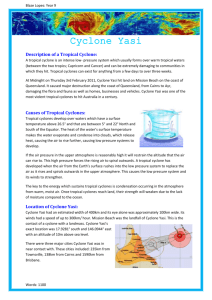Tropical Cyclone Yasi – Report
advertisement
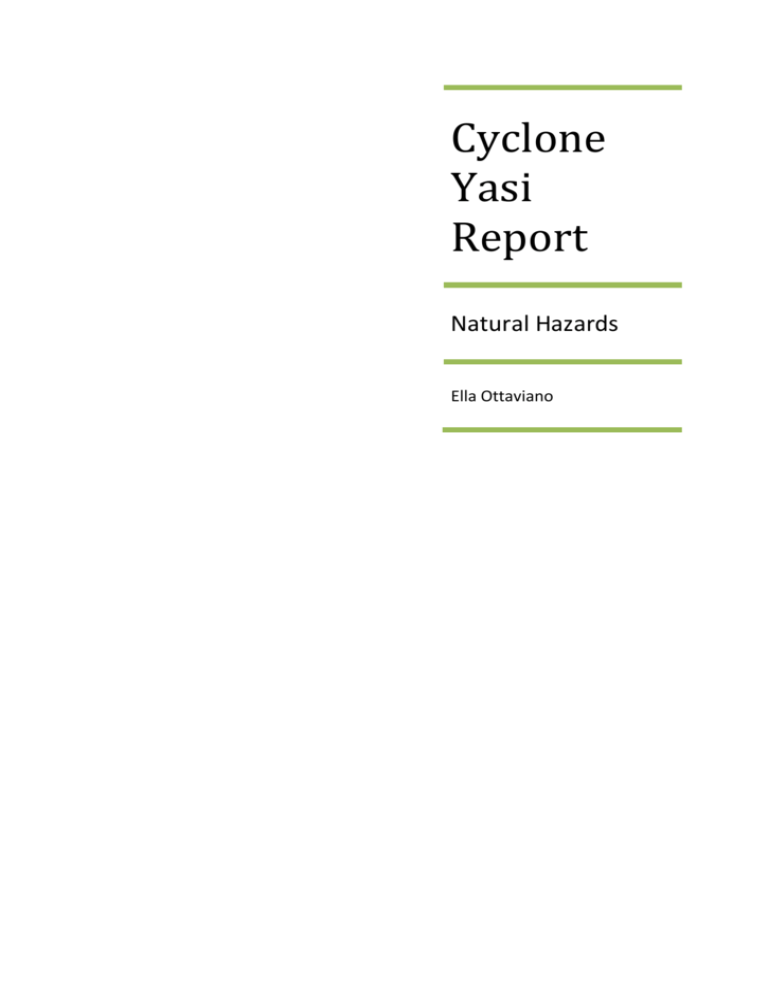
Cyclone Yasi Report Natural Hazards Ella Ottaviano Cyclone Yasi – Natural Hazards Research Report What is a Cyclone? A tropical cyclone is a strong low-pressure system that develops over warm oceans (around the Equator). It is a system of spiralling winds and storm clouds. In the Southern Hemisphere the winds rotate clockwise and are called cyclones whereas it is the opposite in the Northern Hemisphere where they are also often referred to as hurricanes or typhoons. The most common features are destructive winds and heavy rainfall that can lead to flooding. Tropical cyclones can cause devastating damage once they reach land; powerful winds and rain destroy almost everything in its path. In order for it to be categorised as a cyclone, its average sustained wind speed needs to exceed 63 kilometres per hour. To be classified as severe, the average sustained wind speed needs to exceed 118 kilometres per hour. Although tropical cyclones have a reputation for being unpredictable, much effort has been dedicated to improving the forecasting skill of both location and intensity by the Bureau of Meteorology Causes of Cyclone Yasi Yasi was formed and developed the same way as most other cyclones. Cyclones occur over warm seas (a temperature greater than 26°C) near the equator. Heated air rising over warm seas causes low pressure systems to develop. As the air rises it becomes more and more moist. The moist air condenses into large storm clouds. Cool air rushes down to fill the void but because of the turning of the Earth, the air is bent inwards and begins to spiral upwards with extreme force. The swirling winds create a large circle in the centre of the clouds, and this becomes the eye of the storm, where the winds are fairly calm and there is no rain or cloud cover. The cyclone builds up and is sustained by the warm, moist air condensing. When the cyclone hits land or travels over cooler sea there is no warm air and the cyclone begins to lose intensity. Diagram of how a cyclone works Location of Cyclone Yasi Cyclone Yasi travelled over the ocean for some time before hitting land in the early hours of Thursday, 3 February in north Queensland at Mission Beach. Mission Beach is located at 17° 52' 16" S latitude and 146° 06' 19" E longitude and sits 10 meters above sea level. The nearest major town is Innisfail and is approximately 40km away from Mission Beach. Some of the places inflicted with the worst damage were around the areas of Tully, Tully Heads, Silkwood, Mission Beach, Innisfail and Cardwell. Path of Cyclone Yasi Landform and Climate Mission Beach is situated on the coast on the very north side of the beach. Just off the coastline there is a small part of the Great Barrier Reef. Surrounding the area is farmland and mountains with tropical rainforests with the lush, thick dense coverage of trees and plants. Mission beach climate is often very humid and hot, generally tropical climate. Mission Beach has a monsoonal or ‘Wet Season’ from January to May when most of the 3000mm of rain per year falls. At this time that is both hot and wet (this was the period when the Yasi hit – lots of warm, moist air). The ‘Dry Season’, from June to September, is much like a northern hemisphere summer with warm sunny days and cooler nights. The cyclone season occurs from November through to April. When Cyclone Yasi hit land at Mission Beach it was very powerful and destroyed the homes and killed many native animals like Echidnas and possums, the vast numbers of birds and animals living on the rainforest covered mountains as well as destroying crops, such as bananas, on farms impacting severely on the town community. A climate graph of Innisfail for 2011. Social, Economic and Environmental Changes Social Changes Cyclone Yasi brought not only the whole of Queensland together but reached out to the whole of Australia with people from everywhere helping to rebuild. Families coping with sadness of injury, destruction of property etc. Many local communities are coming together to raise money for victims of the hazard, both affected communities and non. Neighbours coming together to help clean up. More than 400 Red Cross volunteers assisting. Economic Changes Estimated $3.6 Billion dollars worth of damage to Queenslanders. Economy will slow down due to destruction of businesses and industries and tourism declining after the natural hazard. National levy (one-off). Loss of income for people (destruction of businesses) Increased prices of food due to shortage because crops were destroyed. Closure of businesses. Rise of rent, due to the increased need to rent because homes have been destroyed. Rise of insurance premiums because of the amount of claims. Environmental Changes Many trees plants were destroyed by the cyclone along with the homes of the animals that inhabit these places. Many native animals were either killed or injured. There was also rubbish blown everywhere, some people (on the coast) reported pumice and coconuts washed up on their lawn. Destroyed infrastructure must be demolished and rebuilt along with destroyed crops and farms. 70 year old Michael Geyer looks through his destroyed banana crop Evaluation of Responses Individuals Helping care for the injured wildlife. “One wildlife carer we spoke to had accepted 34 birds in one day, and had six more on the way.” Individuals have shown resilience through Aussie larrikin attitude. A sign in a boarded up cafe window read ‘Kiss my Yasi’. Helping others clean up damage and mess. Groups The Red Cross has more than 400 volunteers working with victims and helping to raise money. Local Disaster Management Groups have helped out, restoring power and search for missing people. Emergency services answered numerous calls for help throughout the night and day. The police and paramedics helped by making, emergency repairs water and sewerage pipes, bringing supplies and equipment for stranded families and provided medical assistance to injured. Government The government introduced a nation one-off levy to assist victims in rebuilding their lives. Prime Minister Julia Gillard said today all Army 4000 troops based in Townsville would aid north Queensland's recovery. Extra 150 police and 500 State Emergency Service personnel are being sent to north Queensland to help the clean-up. The Australian Army also helped evacuate people in immediate danger (coastal areas) when warnings of the cyclone came in. Helped rebuild towns and repair damage. Army personnel helping clean up streets. Bibliography Sites used: http://www.bom.gov.au/cyclone/history/yasi.shtml http://www.bbc.co.uk/schools/gcsebitesize/geography/natural_hazards/hurricanes_rev1.sh tml http://library.thinkquest.org/10136/cyclones/cycltq.htm#how http://www.cairns.com.au/article/2012/01/28/202881_cyclone.html http://www.mission-beach-au.com/weather-and-climate http://www.missionbeachtourism.com/about-mission-beach/cyclone-yasi.php http://weather.ninemsn.com.au/climate/station.jsp?lt=site&lc=32025 http://moneybasics.nab.com.au/the-economic-impact-of-the-floods-and-yasi-267.html http://www.ifaw.org/united-states/node/2607 http://www.heraldsun.com.au/opinion/aussie-spirit-will-beat-cyclone-yasi/story-e6frfhqo1225999136927 http://www.heraldsun.com.au/news/special-reports/queensland-cyclone-yasi/storyfn7rxoal-1225998348468 http://www.ga.gov.au/hazards/cyclone/cyclone-basics/what.html http://www.ema.gov.au/www/ema/schools.nsf/Page/Get_The_FactsCyclones


